Evaluating the Effectiveness of Immunization in Public Health
VerifiedAdded on 2023/04/21
|9
|2334
|235
Report
AI Summary
This report examines the critical role of immunization, or vaccination, in preventing diseases and safeguarding public health. It begins with a historical overview of immunization, tracing its origins and highlighting key advancements, such as Edward Jenner's pioneering work and Louis Pasteur's contributions. The report then delves into the effectiveness of vaccines in protecting against various pathogens, including rubella, measles, and whooping cough, while also addressing public concerns about vaccine safety. It discusses the concept of herd immunity and its importance in disease eradication and elimination efforts, using examples like the eradication of smallpox and the ongoing efforts to eliminate polio and measles. The report further analyzes the role of government funding and initiatives, particularly focusing on the Australian government's investment in immunization programs and the impact of policies like 'no jab, no play.' The report concludes by emphasizing the importance of immunization in promoting public health and calls for continued investment and expansion of these programs to remote areas, underscoring the vital role of vaccination in global health.
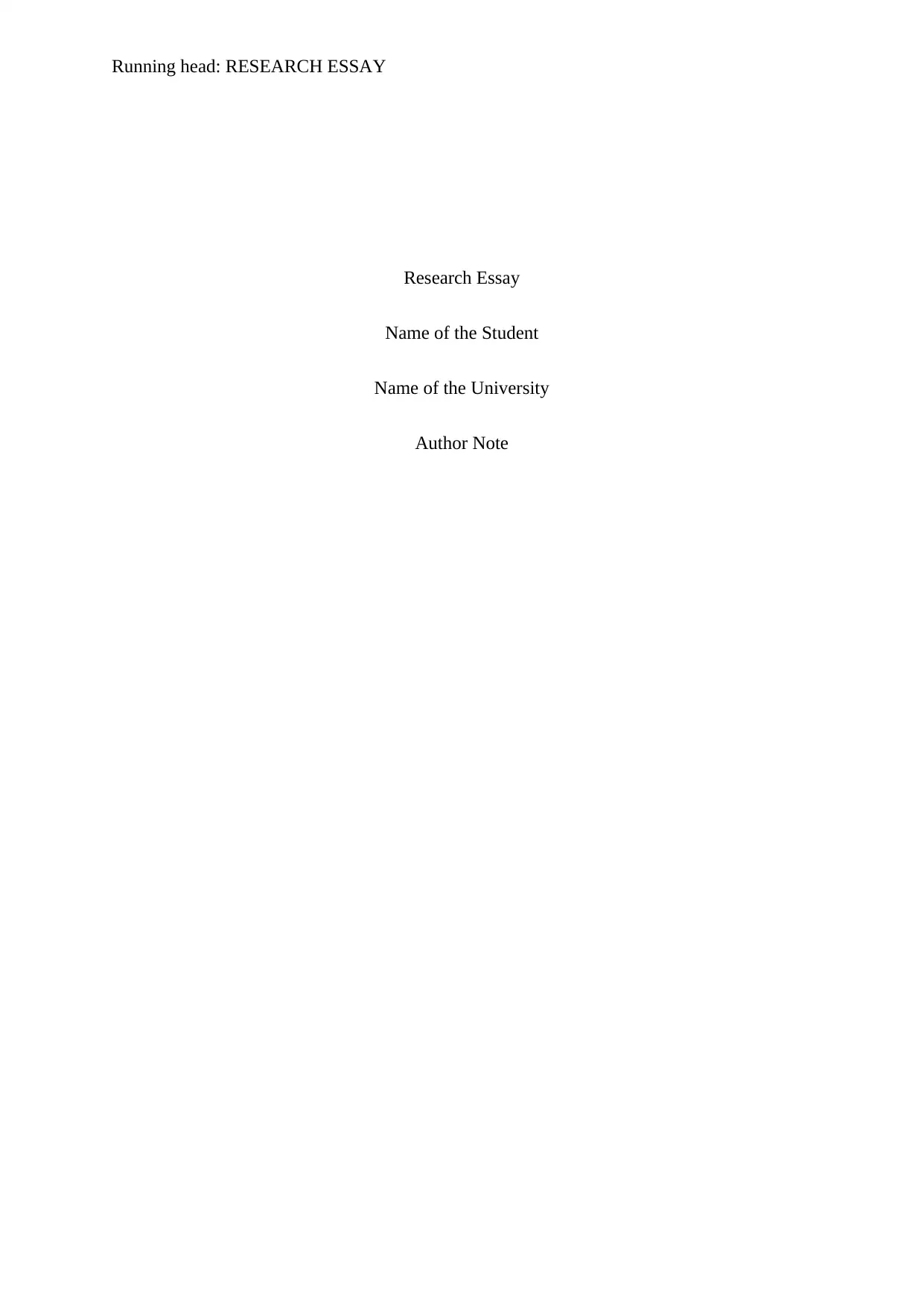
Running head: RESEARCH ESSAY
Research Essay
Name of the Student
Name of the University
Author Note
Research Essay
Name of the Student
Name of the University
Author Note
Paraphrase This Document
Need a fresh take? Get an instant paraphrase of this document with our AI Paraphraser
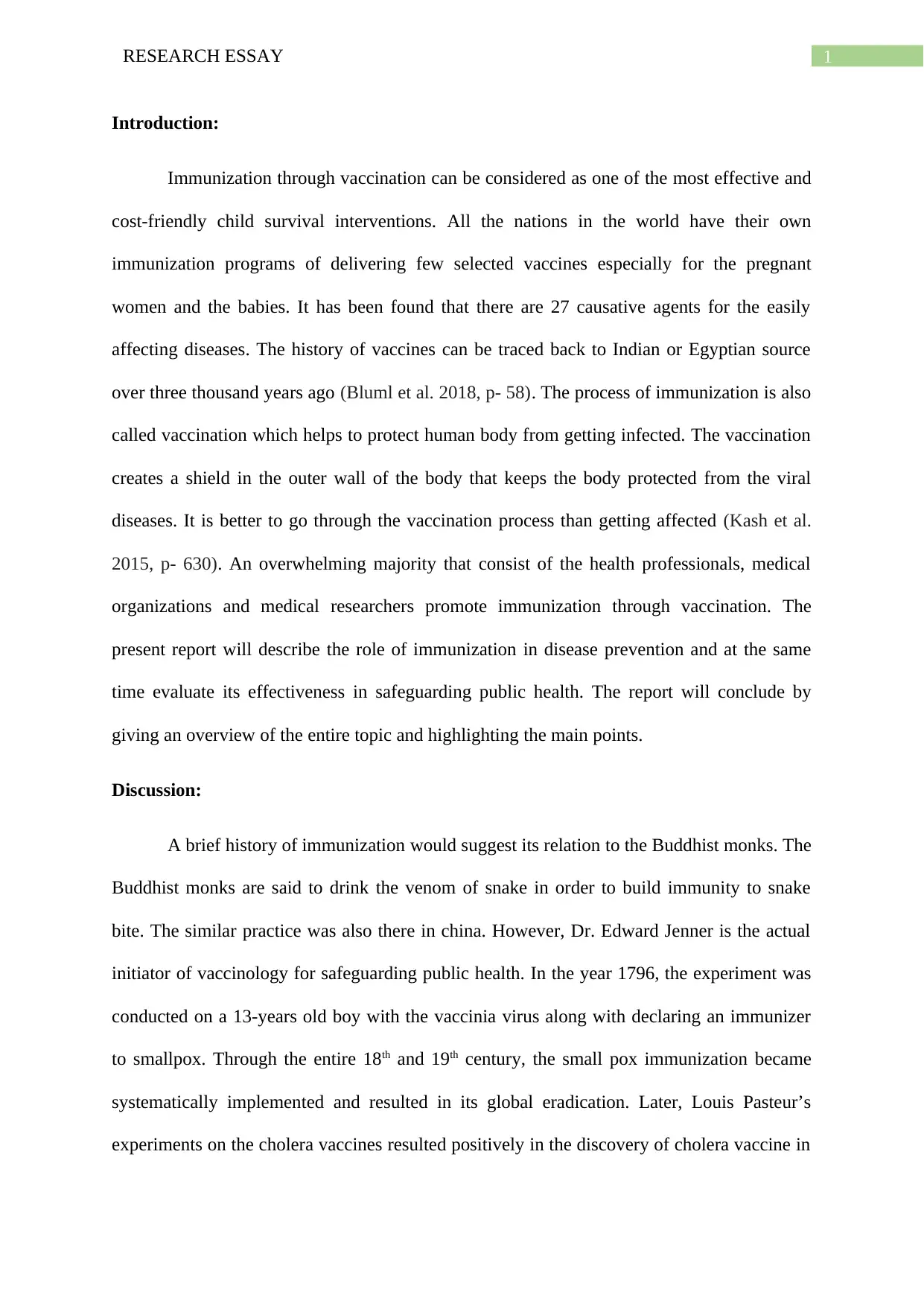
1RESEARCH ESSAY
Introduction:
Immunization through vaccination can be considered as one of the most effective and
cost-friendly child survival interventions. All the nations in the world have their own
immunization programs of delivering few selected vaccines especially for the pregnant
women and the babies. It has been found that there are 27 causative agents for the easily
affecting diseases. The history of vaccines can be traced back to Indian or Egyptian source
over three thousand years ago (Bluml et al. 2018, p- 58). The process of immunization is also
called vaccination which helps to protect human body from getting infected. The vaccination
creates a shield in the outer wall of the body that keeps the body protected from the viral
diseases. It is better to go through the vaccination process than getting affected (Kash et al.
2015, p- 630). An overwhelming majority that consist of the health professionals, medical
organizations and medical researchers promote immunization through vaccination. The
present report will describe the role of immunization in disease prevention and at the same
time evaluate its effectiveness in safeguarding public health. The report will conclude by
giving an overview of the entire topic and highlighting the main points.
Discussion:
A brief history of immunization would suggest its relation to the Buddhist monks. The
Buddhist monks are said to drink the venom of snake in order to build immunity to snake
bite. The similar practice was also there in china. However, Dr. Edward Jenner is the actual
initiator of vaccinology for safeguarding public health. In the year 1796, the experiment was
conducted on a 13-years old boy with the vaccinia virus along with declaring an immunizer
to smallpox. Through the entire 18th and 19th century, the small pox immunization became
systematically implemented and resulted in its global eradication. Later, Louis Pasteur’s
experiments on the cholera vaccines resulted positively in the discovery of cholera vaccine in
Introduction:
Immunization through vaccination can be considered as one of the most effective and
cost-friendly child survival interventions. All the nations in the world have their own
immunization programs of delivering few selected vaccines especially for the pregnant
women and the babies. It has been found that there are 27 causative agents for the easily
affecting diseases. The history of vaccines can be traced back to Indian or Egyptian source
over three thousand years ago (Bluml et al. 2018, p- 58). The process of immunization is also
called vaccination which helps to protect human body from getting infected. The vaccination
creates a shield in the outer wall of the body that keeps the body protected from the viral
diseases. It is better to go through the vaccination process than getting affected (Kash et al.
2015, p- 630). An overwhelming majority that consist of the health professionals, medical
organizations and medical researchers promote immunization through vaccination. The
present report will describe the role of immunization in disease prevention and at the same
time evaluate its effectiveness in safeguarding public health. The report will conclude by
giving an overview of the entire topic and highlighting the main points.
Discussion:
A brief history of immunization would suggest its relation to the Buddhist monks. The
Buddhist monks are said to drink the venom of snake in order to build immunity to snake
bite. The similar practice was also there in china. However, Dr. Edward Jenner is the actual
initiator of vaccinology for safeguarding public health. In the year 1796, the experiment was
conducted on a 13-years old boy with the vaccinia virus along with declaring an immunizer
to smallpox. Through the entire 18th and 19th century, the small pox immunization became
systematically implemented and resulted in its global eradication. Later, Louis Pasteur’s
experiments on the cholera vaccines resulted positively in the discovery of cholera vaccine in
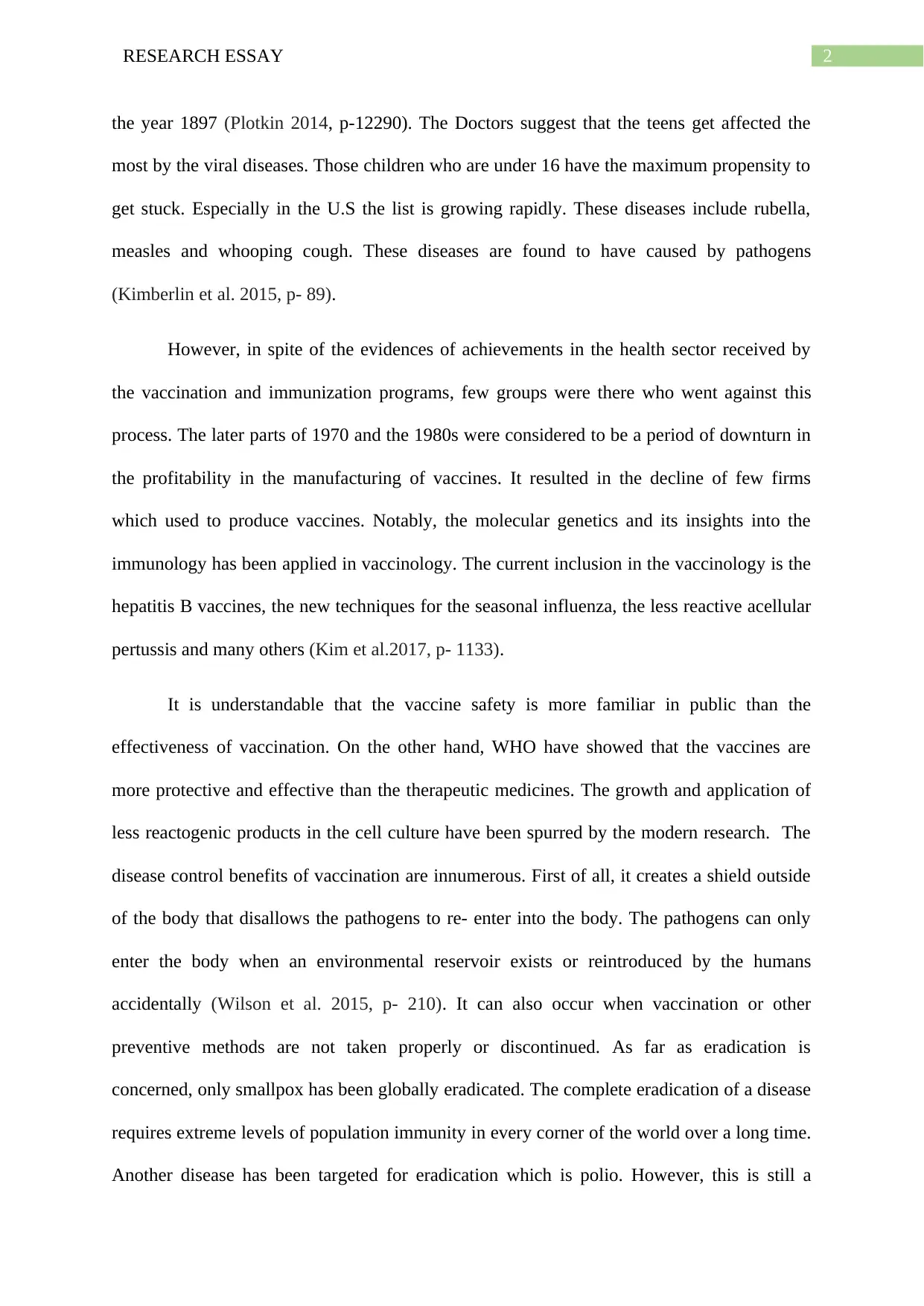
2RESEARCH ESSAY
the year 1897 (Plotkin 2014, p-12290). The Doctors suggest that the teens get affected the
most by the viral diseases. Those children who are under 16 have the maximum propensity to
get stuck. Especially in the U.S the list is growing rapidly. These diseases include rubella,
measles and whooping cough. These diseases are found to have caused by pathogens
(Kimberlin et al. 2015, p- 89).
However, in spite of the evidences of achievements in the health sector received by
the vaccination and immunization programs, few groups were there who went against this
process. The later parts of 1970 and the 1980s were considered to be a period of downturn in
the profitability in the manufacturing of vaccines. It resulted in the decline of few firms
which used to produce vaccines. Notably, the molecular genetics and its insights into the
immunology has been applied in vaccinology. The current inclusion in the vaccinology is the
hepatitis B vaccines, the new techniques for the seasonal influenza, the less reactive acellular
pertussis and many others (Kim et al.2017, p- 1133).
It is understandable that the vaccine safety is more familiar in public than the
effectiveness of vaccination. On the other hand, WHO have showed that the vaccines are
more protective and effective than the therapeutic medicines. The growth and application of
less reactogenic products in the cell culture have been spurred by the modern research. The
disease control benefits of vaccination are innumerous. First of all, it creates a shield outside
of the body that disallows the pathogens to re- enter into the body. The pathogens can only
enter the body when an environmental reservoir exists or reintroduced by the humans
accidentally (Wilson et al. 2015, p- 210). It can also occur when vaccination or other
preventive methods are not taken properly or discontinued. As far as eradication is
concerned, only smallpox has been globally eradicated. The complete eradication of a disease
requires extreme levels of population immunity in every corner of the world over a long time.
Another disease has been targeted for eradication which is polio. However, this is still a
the year 1897 (Plotkin 2014, p-12290). The Doctors suggest that the teens get affected the
most by the viral diseases. Those children who are under 16 have the maximum propensity to
get stuck. Especially in the U.S the list is growing rapidly. These diseases include rubella,
measles and whooping cough. These diseases are found to have caused by pathogens
(Kimberlin et al. 2015, p- 89).
However, in spite of the evidences of achievements in the health sector received by
the vaccination and immunization programs, few groups were there who went against this
process. The later parts of 1970 and the 1980s were considered to be a period of downturn in
the profitability in the manufacturing of vaccines. It resulted in the decline of few firms
which used to produce vaccines. Notably, the molecular genetics and its insights into the
immunology has been applied in vaccinology. The current inclusion in the vaccinology is the
hepatitis B vaccines, the new techniques for the seasonal influenza, the less reactive acellular
pertussis and many others (Kim et al.2017, p- 1133).
It is understandable that the vaccine safety is more familiar in public than the
effectiveness of vaccination. On the other hand, WHO have showed that the vaccines are
more protective and effective than the therapeutic medicines. The growth and application of
less reactogenic products in the cell culture have been spurred by the modern research. The
disease control benefits of vaccination are innumerous. First of all, it creates a shield outside
of the body that disallows the pathogens to re- enter into the body. The pathogens can only
enter the body when an environmental reservoir exists or reintroduced by the humans
accidentally (Wilson et al. 2015, p- 210). It can also occur when vaccination or other
preventive methods are not taken properly or discontinued. As far as eradication is
concerned, only smallpox has been globally eradicated. The complete eradication of a disease
requires extreme levels of population immunity in every corner of the world over a long time.
Another disease has been targeted for eradication which is polio. However, this is still a
⊘ This is a preview!⊘
Do you want full access?
Subscribe today to unlock all pages.

Trusted by 1+ million students worldwide
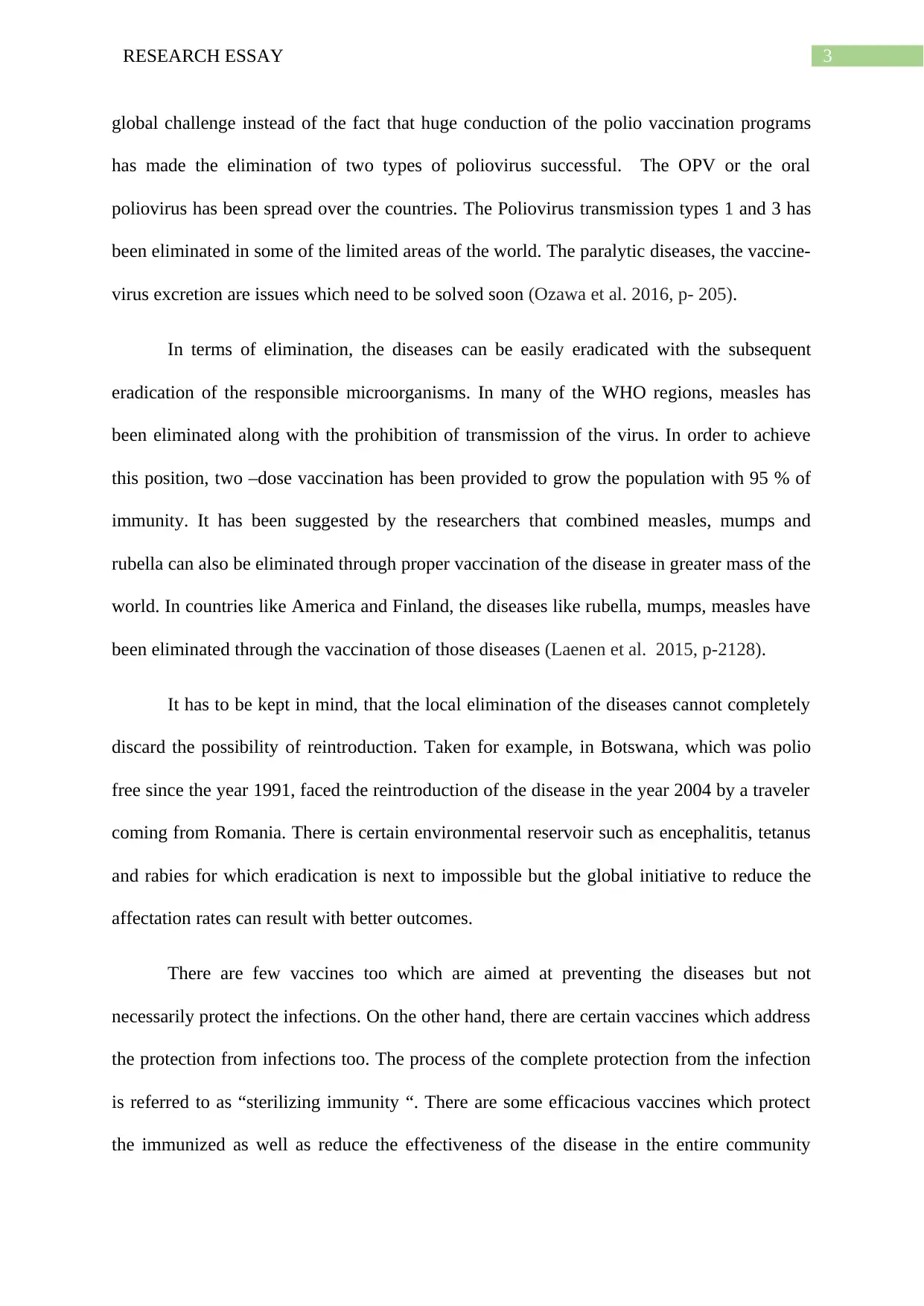
3RESEARCH ESSAY
global challenge instead of the fact that huge conduction of the polio vaccination programs
has made the elimination of two types of poliovirus successful. The OPV or the oral
poliovirus has been spread over the countries. The Poliovirus transmission types 1 and 3 has
been eliminated in some of the limited areas of the world. The paralytic diseases, the vaccine-
virus excretion are issues which need to be solved soon (Ozawa et al. 2016, p- 205).
In terms of elimination, the diseases can be easily eradicated with the subsequent
eradication of the responsible microorganisms. In many of the WHO regions, measles has
been eliminated along with the prohibition of transmission of the virus. In order to achieve
this position, two –dose vaccination has been provided to grow the population with 95 % of
immunity. It has been suggested by the researchers that combined measles, mumps and
rubella can also be eliminated through proper vaccination of the disease in greater mass of the
world. In countries like America and Finland, the diseases like rubella, mumps, measles have
been eliminated through the vaccination of those diseases (Laenen et al. 2015, p-2128).
It has to be kept in mind, that the local elimination of the diseases cannot completely
discard the possibility of reintroduction. Taken for example, in Botswana, which was polio
free since the year 1991, faced the reintroduction of the disease in the year 2004 by a traveler
coming from Romania. There is certain environmental reservoir such as encephalitis, tetanus
and rabies for which eradication is next to impossible but the global initiative to reduce the
affectation rates can result with better outcomes.
There are few vaccines too which are aimed at preventing the diseases but not
necessarily protect the infections. On the other hand, there are certain vaccines which address
the protection from infections too. The process of the complete protection from the infection
is referred to as “sterilizing immunity “. There are some efficacious vaccines which protect
the immunized as well as reduce the effectiveness of the disease in the entire community
global challenge instead of the fact that huge conduction of the polio vaccination programs
has made the elimination of two types of poliovirus successful. The OPV or the oral
poliovirus has been spread over the countries. The Poliovirus transmission types 1 and 3 has
been eliminated in some of the limited areas of the world. The paralytic diseases, the vaccine-
virus excretion are issues which need to be solved soon (Ozawa et al. 2016, p- 205).
In terms of elimination, the diseases can be easily eradicated with the subsequent
eradication of the responsible microorganisms. In many of the WHO regions, measles has
been eliminated along with the prohibition of transmission of the virus. In order to achieve
this position, two –dose vaccination has been provided to grow the population with 95 % of
immunity. It has been suggested by the researchers that combined measles, mumps and
rubella can also be eliminated through proper vaccination of the disease in greater mass of the
world. In countries like America and Finland, the diseases like rubella, mumps, measles have
been eliminated through the vaccination of those diseases (Laenen et al. 2015, p-2128).
It has to be kept in mind, that the local elimination of the diseases cannot completely
discard the possibility of reintroduction. Taken for example, in Botswana, which was polio
free since the year 1991, faced the reintroduction of the disease in the year 2004 by a traveler
coming from Romania. There is certain environmental reservoir such as encephalitis, tetanus
and rabies for which eradication is next to impossible but the global initiative to reduce the
affectation rates can result with better outcomes.
There are few vaccines too which are aimed at preventing the diseases but not
necessarily protect the infections. On the other hand, there are certain vaccines which address
the protection from infections too. The process of the complete protection from the infection
is referred to as “sterilizing immunity “. There are some efficacious vaccines which protect
the immunized as well as reduce the effectiveness of the disease in the entire community
Paraphrase This Document
Need a fresh take? Get an instant paraphrase of this document with our AI Paraphraser
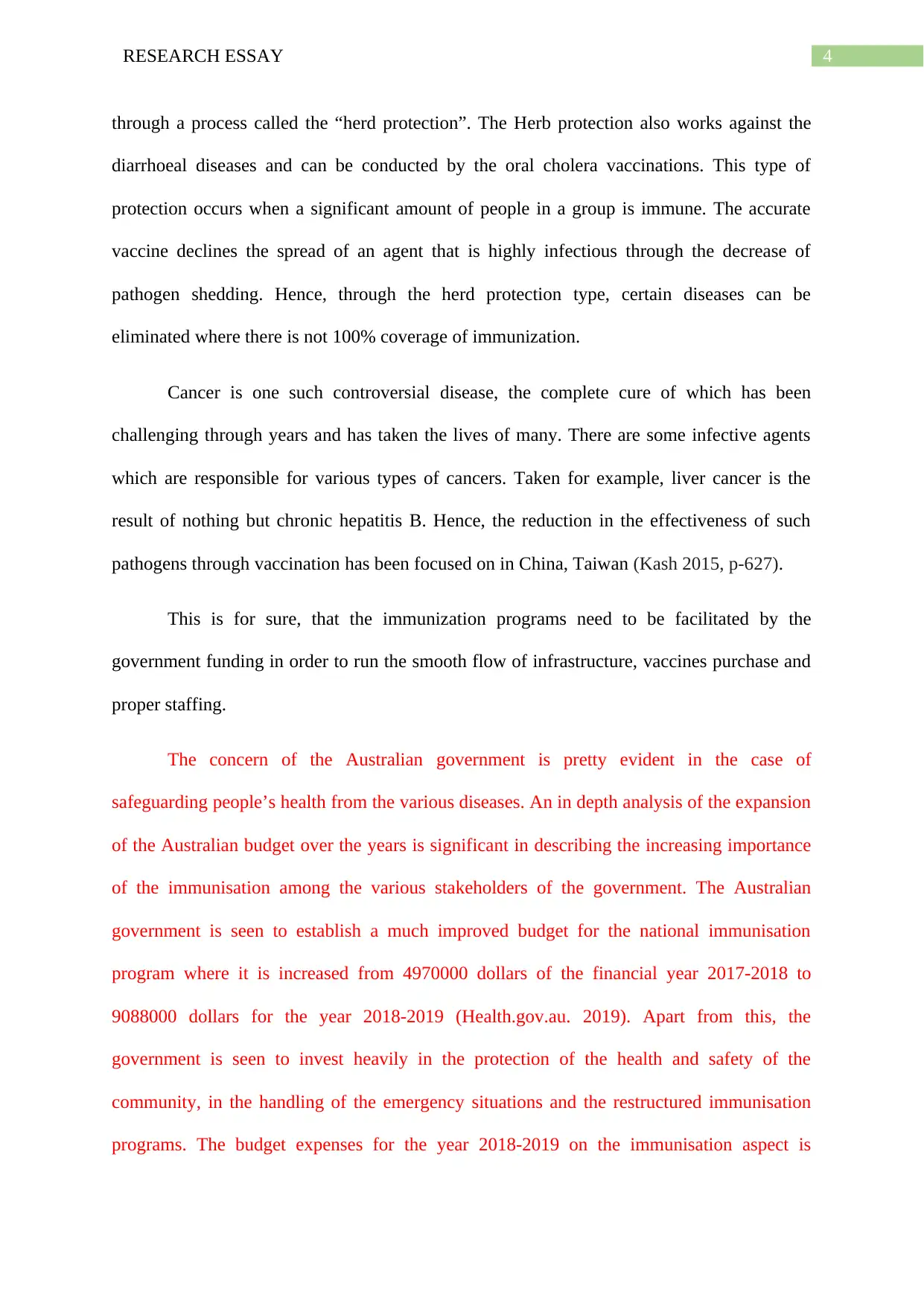
4RESEARCH ESSAY
through a process called the “herd protection”. The Herb protection also works against the
diarrhoeal diseases and can be conducted by the oral cholera vaccinations. This type of
protection occurs when a significant amount of people in a group is immune. The accurate
vaccine declines the spread of an agent that is highly infectious through the decrease of
pathogen shedding. Hence, through the herd protection type, certain diseases can be
eliminated where there is not 100% coverage of immunization.
Cancer is one such controversial disease, the complete cure of which has been
challenging through years and has taken the lives of many. There are some infective agents
which are responsible for various types of cancers. Taken for example, liver cancer is the
result of nothing but chronic hepatitis B. Hence, the reduction in the effectiveness of such
pathogens through vaccination has been focused on in China, Taiwan (Kash 2015, p-627).
This is for sure, that the immunization programs need to be facilitated by the
government funding in order to run the smooth flow of infrastructure, vaccines purchase and
proper staffing.
The concern of the Australian government is pretty evident in the case of
safeguarding people’s health from the various diseases. An in depth analysis of the expansion
of the Australian budget over the years is significant in describing the increasing importance
of the immunisation among the various stakeholders of the government. The Australian
government is seen to establish a much improved budget for the national immunisation
program where it is increased from 4970000 dollars of the financial year 2017-2018 to
9088000 dollars for the year 2018-2019 (Health.gov.au. 2019). Apart from this, the
government is seen to invest heavily in the protection of the health and safety of the
community, in the handling of the emergency situations and the restructured immunisation
programs. The budget expenses for the year 2018-2019 on the immunisation aspect is
through a process called the “herd protection”. The Herb protection also works against the
diarrhoeal diseases and can be conducted by the oral cholera vaccinations. This type of
protection occurs when a significant amount of people in a group is immune. The accurate
vaccine declines the spread of an agent that is highly infectious through the decrease of
pathogen shedding. Hence, through the herd protection type, certain diseases can be
eliminated where there is not 100% coverage of immunization.
Cancer is one such controversial disease, the complete cure of which has been
challenging through years and has taken the lives of many. There are some infective agents
which are responsible for various types of cancers. Taken for example, liver cancer is the
result of nothing but chronic hepatitis B. Hence, the reduction in the effectiveness of such
pathogens through vaccination has been focused on in China, Taiwan (Kash 2015, p-627).
This is for sure, that the immunization programs need to be facilitated by the
government funding in order to run the smooth flow of infrastructure, vaccines purchase and
proper staffing.
The concern of the Australian government is pretty evident in the case of
safeguarding people’s health from the various diseases. An in depth analysis of the expansion
of the Australian budget over the years is significant in describing the increasing importance
of the immunisation among the various stakeholders of the government. The Australian
government is seen to establish a much improved budget for the national immunisation
program where it is increased from 4970000 dollars of the financial year 2017-2018 to
9088000 dollars for the year 2018-2019 (Health.gov.au. 2019). Apart from this, the
government is seen to invest heavily in the protection of the health and safety of the
community, in the handling of the emergency situations and the restructured immunisation
programs. The budget expenses for the year 2018-2019 on the immunisation aspect is
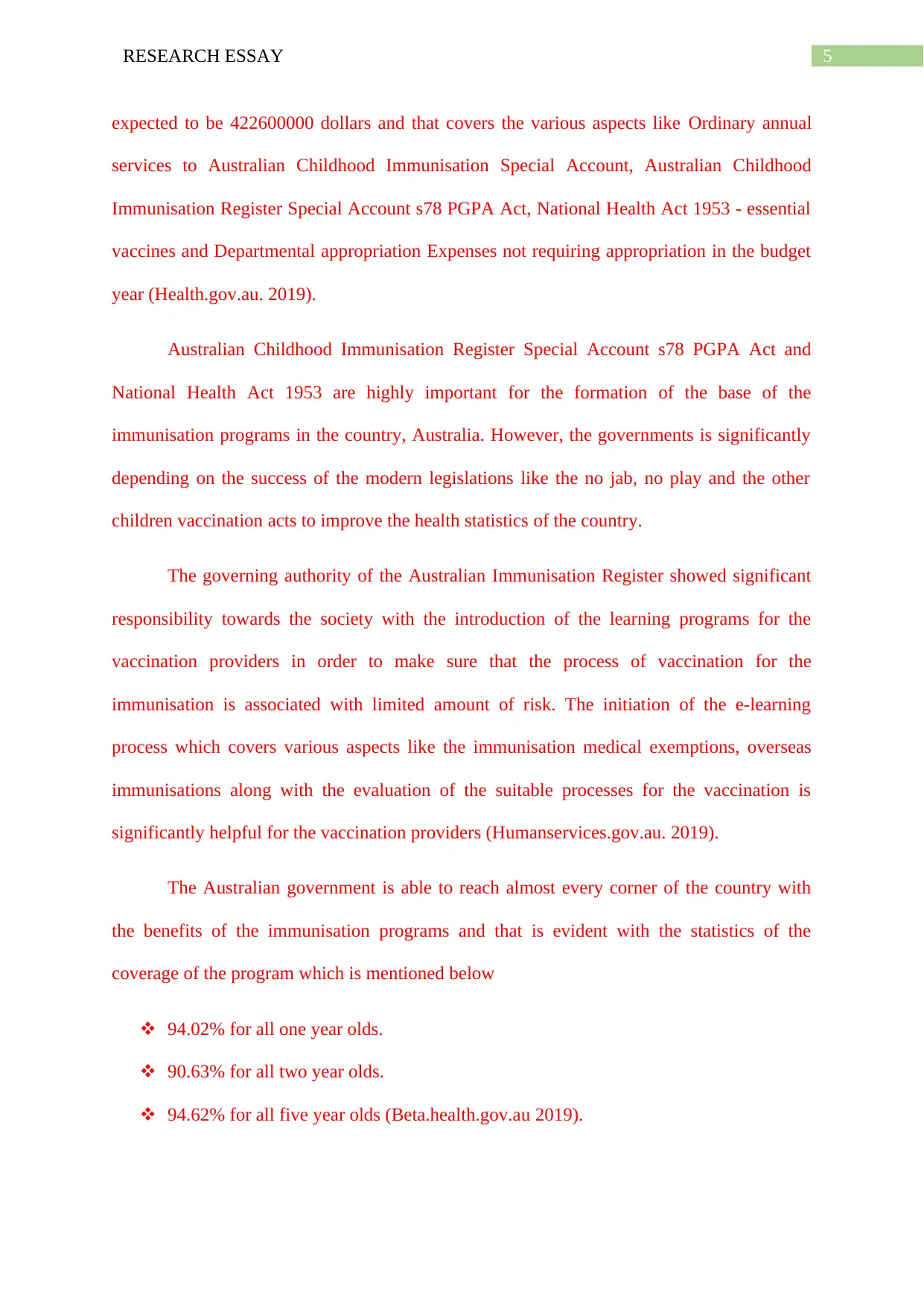
5RESEARCH ESSAY
expected to be 422600000 dollars and that covers the various aspects like Ordinary annual
services to Australian Childhood Immunisation Special Account, Australian Childhood
Immunisation Register Special Account s78 PGPA Act, National Health Act 1953 - essential
vaccines and Departmental appropriation Expenses not requiring appropriation in the budget
year (Health.gov.au. 2019).
Australian Childhood Immunisation Register Special Account s78 PGPA Act and
National Health Act 1953 are highly important for the formation of the base of the
immunisation programs in the country, Australia. However, the governments is significantly
depending on the success of the modern legislations like the no jab, no play and the other
children vaccination acts to improve the health statistics of the country.
The governing authority of the Australian Immunisation Register showed significant
responsibility towards the society with the introduction of the learning programs for the
vaccination providers in order to make sure that the process of vaccination for the
immunisation is associated with limited amount of risk. The initiation of the e-learning
process which covers various aspects like the immunisation medical exemptions, overseas
immunisations along with the evaluation of the suitable processes for the vaccination is
significantly helpful for the vaccination providers (Humanservices.gov.au. 2019).
The Australian government is able to reach almost every corner of the country with
the benefits of the immunisation programs and that is evident with the statistics of the
coverage of the program which is mentioned below
94.02% for all one year olds.
90.63% for all two year olds.
94.62% for all five year olds (Beta.health.gov.au 2019).
expected to be 422600000 dollars and that covers the various aspects like Ordinary annual
services to Australian Childhood Immunisation Special Account, Australian Childhood
Immunisation Register Special Account s78 PGPA Act, National Health Act 1953 - essential
vaccines and Departmental appropriation Expenses not requiring appropriation in the budget
year (Health.gov.au. 2019).
Australian Childhood Immunisation Register Special Account s78 PGPA Act and
National Health Act 1953 are highly important for the formation of the base of the
immunisation programs in the country, Australia. However, the governments is significantly
depending on the success of the modern legislations like the no jab, no play and the other
children vaccination acts to improve the health statistics of the country.
The governing authority of the Australian Immunisation Register showed significant
responsibility towards the society with the introduction of the learning programs for the
vaccination providers in order to make sure that the process of vaccination for the
immunisation is associated with limited amount of risk. The initiation of the e-learning
process which covers various aspects like the immunisation medical exemptions, overseas
immunisations along with the evaluation of the suitable processes for the vaccination is
significantly helpful for the vaccination providers (Humanservices.gov.au. 2019).
The Australian government is able to reach almost every corner of the country with
the benefits of the immunisation programs and that is evident with the statistics of the
coverage of the program which is mentioned below
94.02% for all one year olds.
90.63% for all two year olds.
94.62% for all five year olds (Beta.health.gov.au 2019).
⊘ This is a preview!⊘
Do you want full access?
Subscribe today to unlock all pages.

Trusted by 1+ million students worldwide
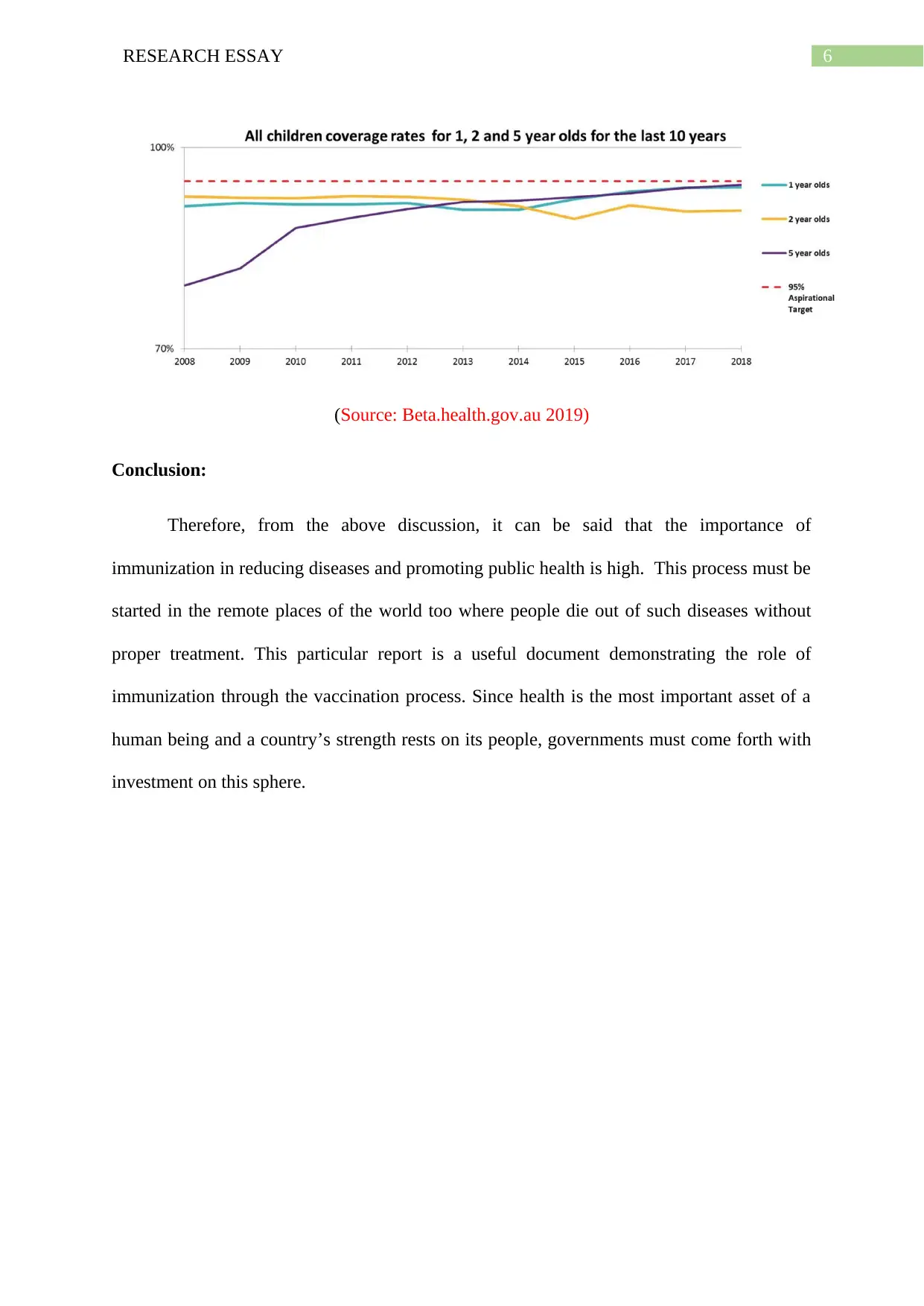
6RESEARCH ESSAY
(Source: Beta.health.gov.au 2019)
Conclusion:
Therefore, from the above discussion, it can be said that the importance of
immunization in reducing diseases and promoting public health is high. This process must be
started in the remote places of the world too where people die out of such diseases without
proper treatment. This particular report is a useful document demonstrating the role of
immunization through the vaccination process. Since health is the most important asset of a
human being and a country’s strength rests on its people, governments must come forth with
investment on this sphere.
(Source: Beta.health.gov.au 2019)
Conclusion:
Therefore, from the above discussion, it can be said that the importance of
immunization in reducing diseases and promoting public health is high. This process must be
started in the remote places of the world too where people die out of such diseases without
proper treatment. This particular report is a useful document demonstrating the role of
immunization through the vaccination process. Since health is the most important asset of a
human being and a country’s strength rests on its people, governments must come forth with
investment on this sphere.
Paraphrase This Document
Need a fresh take? Get an instant paraphrase of this document with our AI Paraphraser
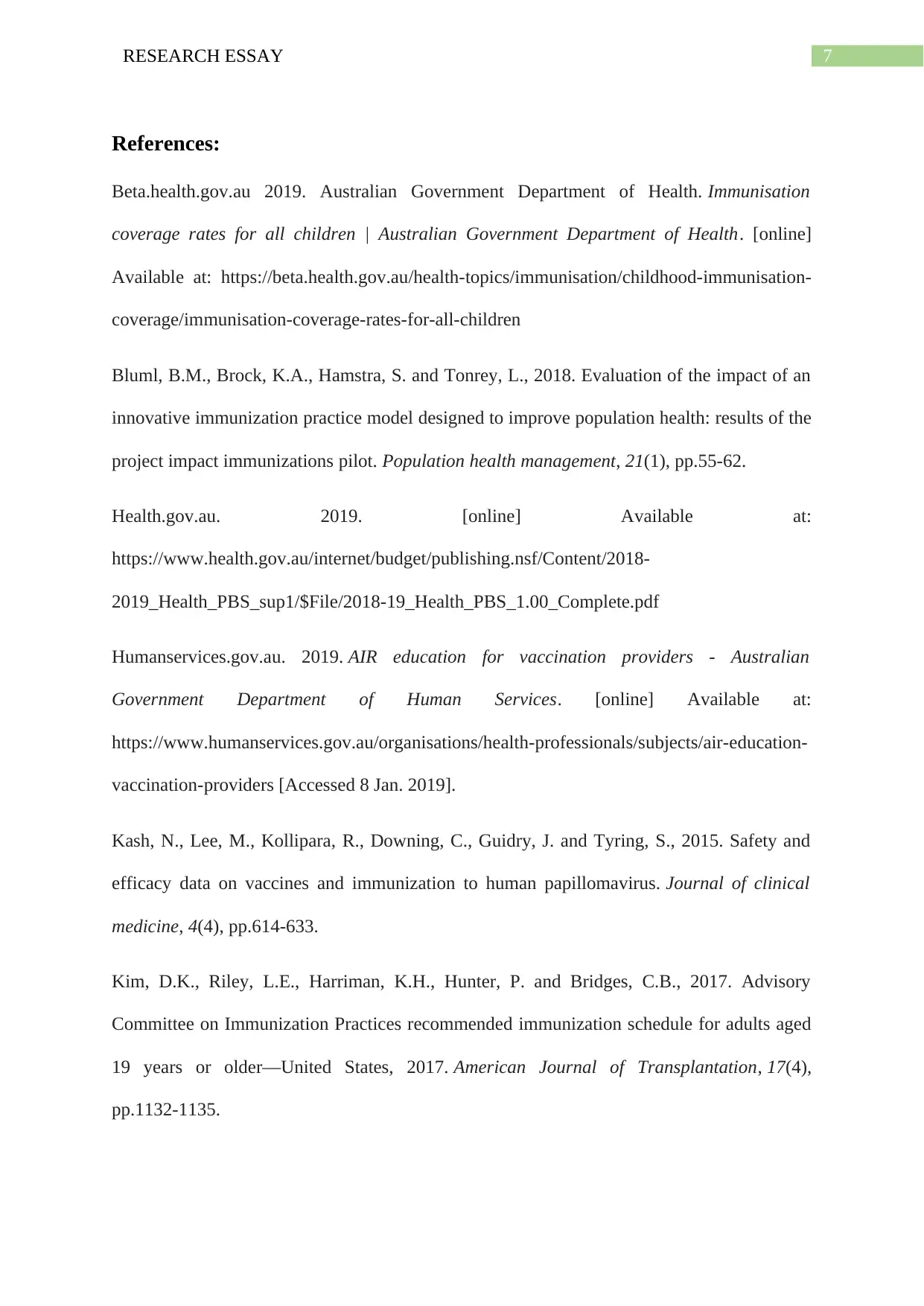
7RESEARCH ESSAY
References:
Beta.health.gov.au 2019. Australian Government Department of Health. Immunisation
coverage rates for all children | Australian Government Department of Health. [online]
Available at: https://beta.health.gov.au/health-topics/immunisation/childhood-immunisation-
coverage/immunisation-coverage-rates-for-all-children
Bluml, B.M., Brock, K.A., Hamstra, S. and Tonrey, L., 2018. Evaluation of the impact of an
innovative immunization practice model designed to improve population health: results of the
project impact immunizations pilot. Population health management, 21(1), pp.55-62.
Health.gov.au. 2019. [online] Available at:
https://www.health.gov.au/internet/budget/publishing.nsf/Content/2018-
2019_Health_PBS_sup1/$File/2018-19_Health_PBS_1.00_Complete.pdf
Humanservices.gov.au. 2019. AIR education for vaccination providers - Australian
Government Department of Human Services. [online] Available at:
https://www.humanservices.gov.au/organisations/health-professionals/subjects/air-education-
vaccination-providers [Accessed 8 Jan. 2019].
Kash, N., Lee, M., Kollipara, R., Downing, C., Guidry, J. and Tyring, S., 2015. Safety and
efficacy data on vaccines and immunization to human papillomavirus. Journal of clinical
medicine, 4(4), pp.614-633.
Kim, D.K., Riley, L.E., Harriman, K.H., Hunter, P. and Bridges, C.B., 2017. Advisory
Committee on Immunization Practices recommended immunization schedule for adults aged
19 years or older—United States, 2017. American Journal of Transplantation, 17(4),
pp.1132-1135.
References:
Beta.health.gov.au 2019. Australian Government Department of Health. Immunisation
coverage rates for all children | Australian Government Department of Health. [online]
Available at: https://beta.health.gov.au/health-topics/immunisation/childhood-immunisation-
coverage/immunisation-coverage-rates-for-all-children
Bluml, B.M., Brock, K.A., Hamstra, S. and Tonrey, L., 2018. Evaluation of the impact of an
innovative immunization practice model designed to improve population health: results of the
project impact immunizations pilot. Population health management, 21(1), pp.55-62.
Health.gov.au. 2019. [online] Available at:
https://www.health.gov.au/internet/budget/publishing.nsf/Content/2018-
2019_Health_PBS_sup1/$File/2018-19_Health_PBS_1.00_Complete.pdf
Humanservices.gov.au. 2019. AIR education for vaccination providers - Australian
Government Department of Human Services. [online] Available at:
https://www.humanservices.gov.au/organisations/health-professionals/subjects/air-education-
vaccination-providers [Accessed 8 Jan. 2019].
Kash, N., Lee, M., Kollipara, R., Downing, C., Guidry, J. and Tyring, S., 2015. Safety and
efficacy data on vaccines and immunization to human papillomavirus. Journal of clinical
medicine, 4(4), pp.614-633.
Kim, D.K., Riley, L.E., Harriman, K.H., Hunter, P. and Bridges, C.B., 2017. Advisory
Committee on Immunization Practices recommended immunization schedule for adults aged
19 years or older—United States, 2017. American Journal of Transplantation, 17(4),
pp.1132-1135.
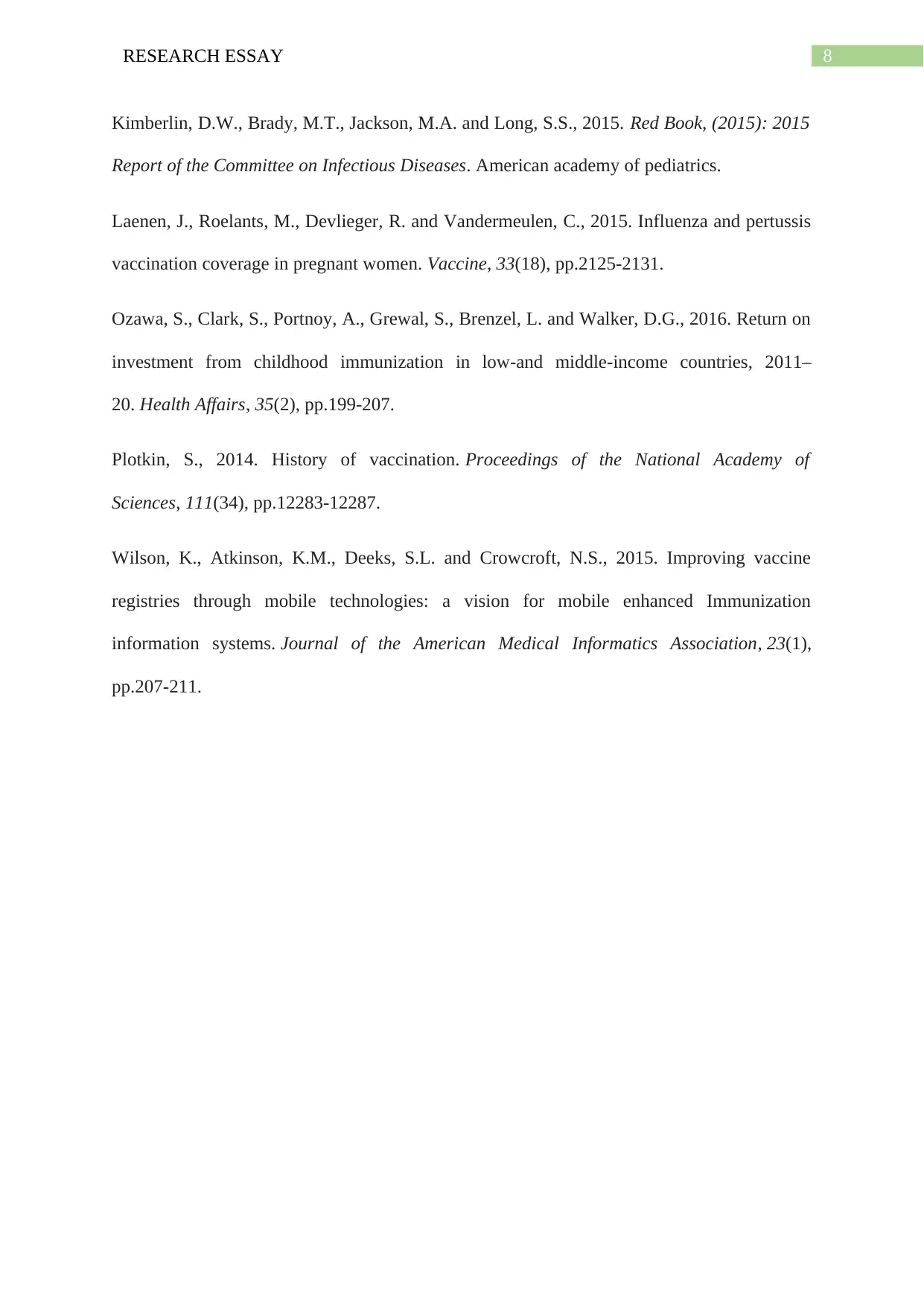
8RESEARCH ESSAY
Kimberlin, D.W., Brady, M.T., Jackson, M.A. and Long, S.S., 2015. Red Book, (2015): 2015
Report of the Committee on Infectious Diseases. American academy of pediatrics.
Laenen, J., Roelants, M., Devlieger, R. and Vandermeulen, C., 2015. Influenza and pertussis
vaccination coverage in pregnant women. Vaccine, 33(18), pp.2125-2131.
Ozawa, S., Clark, S., Portnoy, A., Grewal, S., Brenzel, L. and Walker, D.G., 2016. Return on
investment from childhood immunization in low-and middle-income countries, 2011–
20. Health Affairs, 35(2), pp.199-207.
Plotkin, S., 2014. History of vaccination. Proceedings of the National Academy of
Sciences, 111(34), pp.12283-12287.
Wilson, K., Atkinson, K.M., Deeks, S.L. and Crowcroft, N.S., 2015. Improving vaccine
registries through mobile technologies: a vision for mobile enhanced Immunization
information systems. Journal of the American Medical Informatics Association, 23(1),
pp.207-211.
Kimberlin, D.W., Brady, M.T., Jackson, M.A. and Long, S.S., 2015. Red Book, (2015): 2015
Report of the Committee on Infectious Diseases. American academy of pediatrics.
Laenen, J., Roelants, M., Devlieger, R. and Vandermeulen, C., 2015. Influenza and pertussis
vaccination coverage in pregnant women. Vaccine, 33(18), pp.2125-2131.
Ozawa, S., Clark, S., Portnoy, A., Grewal, S., Brenzel, L. and Walker, D.G., 2016. Return on
investment from childhood immunization in low-and middle-income countries, 2011–
20. Health Affairs, 35(2), pp.199-207.
Plotkin, S., 2014. History of vaccination. Proceedings of the National Academy of
Sciences, 111(34), pp.12283-12287.
Wilson, K., Atkinson, K.M., Deeks, S.L. and Crowcroft, N.S., 2015. Improving vaccine
registries through mobile technologies: a vision for mobile enhanced Immunization
information systems. Journal of the American Medical Informatics Association, 23(1),
pp.207-211.
⊘ This is a preview!⊘
Do you want full access?
Subscribe today to unlock all pages.

Trusted by 1+ million students worldwide
1 out of 9
Related Documents
Your All-in-One AI-Powered Toolkit for Academic Success.
+13062052269
info@desklib.com
Available 24*7 on WhatsApp / Email
![[object Object]](/_next/static/media/star-bottom.7253800d.svg)
Unlock your academic potential
Copyright © 2020–2025 A2Z Services. All Rights Reserved. Developed and managed by ZUCOL.




